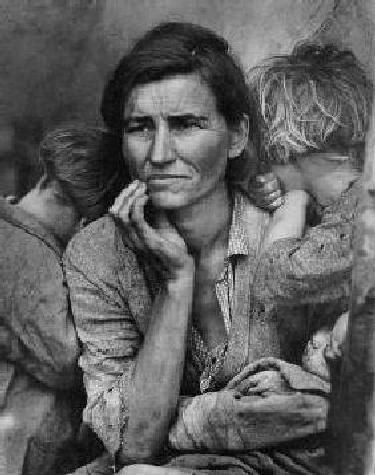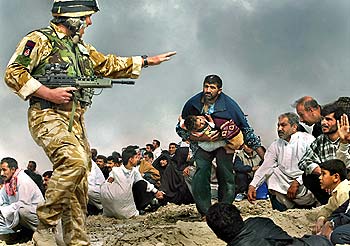August 19, 2006
Thomas Sowell wrote another great peace...er, piece...during the month-long Hezbollah-Israel war. The whole thing should be read, but here I give you what I found to be the relevant excerpts. On second thought, it's difficult to cut out anything. So I'll just highlight what I found to be exceptional:
One of the many failings of our educational system is that it sends out into the world people who cannot tell rhetoric from reality. They have learned no systematic way to analyze ideas, derive their implications and test those implications against hard facts."Peace" movements are among those who take advantage of this widespread inability to see beyond rhetoric to realities. Few people even seem interested in the actual track record of so-called "peace" movements — that is, whether such movements actually produce peace or war.
Take the Middle East. People are calling for a cease-fire in the interests of peace. But there have been more cease-fires in the Middle East than anywhere else. If cease-fires actually promoted peace, the Middle East would be the most peaceful region on the face of the earth instead of the most violent.
Was World War II ended by cease-fires or by annihilating much of Germany and Japan? Make no mistake about it, innocent civilians died in the process. Indeed, American prisoners of war died when we bombed Germany.
There is a reason why General Sherman said "war is hell" more than a century ago. But he helped end the Civil War with his devastating march through Georgia — not by cease fires or bowing to "world opinion" and there were no corrupt busybodies like the United Nations to demand replacing military force with diplomacy.
There was a time when it would have been suicidal to threaten, much less attack, a nation with much stronger military power because one of the dangers to the attacker would be the prospect of being annihilated.
"World opinion," the U.N. and "peace movements" have eliminated that deterrent. An aggressor today knows that if his aggression fails, he will still be protected from the full retaliatory power and fury of those he attacked because there will be hand-wringers demanding a cease fire, negotiations and concessions.
That has been a formula for never-ending attacks on Israel in the Middle East. The disastrous track record of that approach extends to other times and places — but who looks at track records?
Remember the Falkland Islands war, when Argentina sent troops into the Falklands to capture this little British colony in the South Atlantic?
Argentina had been claiming to be the rightful owner of those islands for more than a century. Why didn't it attack these little islands before? At no time did the British have enough troops there to defend them.
Before there were "peace" movements and the U.N., sending troops into those islands could easily have meant finding British troops or bombs in Buenos Aires. Now "world opinion" condemned the British just for sending armed forces into the South Atlantic to take back their islands.
Shamefully, our own government was one of those that opposed the British use of force. But fortunately British prime minister Margaret Thatcher ignored "world opinion" and took back the Falklands.
The most catastrophic result of "peace" movements was World War II. While Hitler was arming Germany to the teeth, "peace" movements in Britain were advocating that their own country disarm "as an example to others."British Labor Party Members of Parliament voted consistently against military spending and British college students publicly pledged never to fight for their country. If "peace" movements brought peace, there would never have been World War II.
Not only did that war lead to tens of millions of deaths, it came dangerously close to a crushing victory for the Nazis in Europe and the Japanese empire in Asia. And we now know that the United States was on Hitler's timetable after that.
For the first two years of that war, the Western democracies lost virtually every battle, all over the world, because pre-war "peace" movements had left them with inadequate military equipment and much of it obsolete. The Nazis and the Japanese knew that. That is why they launched the war.
"Peace" movements don't bring peace but war.
Posted by: Wordsmith at
09:01 AM
| No Comments
| Add Comment
Post contains 827 words, total size 5 kb.
August 13, 2006
Recently the discovery of doctored images shot in South Beirut and the hollywood-esque production of images and video from the hezbollah-occupied village of Qana have sparked a spirited debate in the blogosphere and main stream media over the veracity of the information being released into the MSM.
Kathleen Parker, in her essay at LJWorld.com, reminds us:
Every historic moment has its iconic image. Vietnam had Gen. Nguyen Ngoc Loan executing a Viet Cong on the street; the Oklahoma City bombing had a fireman holding a dying child in his arms; Abu Ghraib had the hooded torture victim standing on a box.And today, the Israeli-Hezbollah war has Qana — the Lebanese village where Israeli rockets killed civilians, including 16 children (down from the initially reported 27)
Or did they?
Makes one wonder about other images that have been seared into our cultural consciousness. As troubling as is to realize the media has reported as fact blatantly manipulated images, it is not a modern phenomenon. As soon as photography was used to capture moments of cultural significance, the manipulation of said images began.
During the American Civil War, a pioneering individual by the name of Matthew Brady organized corps of traveling photographers to document this conflict. One famous photo taken in the aftermath of Gettysburgh shows a the corpse of a Confederate sharpshooter who had fallen at Devils Den.

The photographer, Alexander Gardner, wrote a narrative to go along with the photo which describes the Confederate soldier's lonely, and painful death as rebel sniper. A gripping photograph, perhaps. A staged tableau? Absolutely. The body of the soldier did not fall there, it appears to have been moved from a slope leading up to Devil's Den. Other photographs in this series reveal a suspiciously similar looking corpse lying close by this 'sharpshooters den'. The rifle pictured next to the body is not a snipers rifle, also this rifle has appeared in several other photographs by Gardner, perhaps like some sort of prop.
Years roll by and the technology of photography improves - even women are getting into the act! During the Depression and Dust Bowl of the 1930's, many families migrated to California in search of work. These migrants often lived in harsh conditions as did a widow, Florence Owen, with six of her children. Dorothea Lange, employed by the Farm Security Administration was charged with photographing the plight of the migrant worker. Note: These were American workers doing the jobs that Sen. McCain claimed Americans won't do.

The above photograph is world renown for its encapsulation of the plight and resilience of the migrant worker. Even this image was manipulated in part. Dorothea Owen is pictured with only three of her seven children who were present when this photograph was taken. The staging of the photo was to show that this poor woman would be able to lead her modest flock out of poverty and into prosperity if given the opportunity.
Vietnam: Who can forget the image of the little boy crying as his village lies in burning ruins behind him? No mention of the fact the photographer stepped on the child's foot to get him to start crying in this picture. Perhaps this was the inspiration for Jill Greenbergs exposition "End Times"?
Flash forward 2003: Front page image printed by the LA Times:

This all too perfect image from Basra, Iraq was a compilation of two digital pictures taken by Brian Walski. When asked about the ethics of this, he replied that he really wasn't debating the ethics of when he did this, he just wanted a better picture. How about worrying about the truth of the story instead of creating a picture that meets your preconceived views?
Manipulating an image to influence public opinion is not a modern day phenomenon. The difference today is the with public's ability to challenge the veracity of the information being fed to them through traditional media outlets. The difference is in the truth behind the image is revealed in hours, NOT years.
Posted by: Skye at
11:09 PM
| No Comments
| Add Comment
Post contains 673 words, total size 5 kb.
110 queries taking 0.0648 seconds, 202 records returned.
Powered by Minx 1.1.6c-pink.









